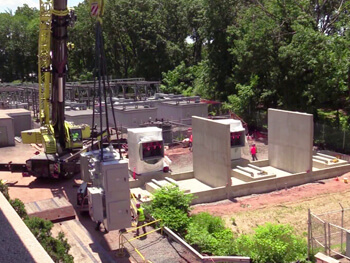Contracting Methods
 At Forest Electric New Jersey, we understand the latest contracting methods and can deploy a wide variety of delivery models to help clients meet their budget goals and scheduling requirements.
At Forest Electric New Jersey, we understand the latest contracting methods and can deploy a wide variety of delivery models to help clients meet their budget goals and scheduling requirements.
Design-Build
A successful design-build approach leverages a single-point of contact to help deliver more accurate estimates, reduce costs, and develop a detailed scope of work that reflects accurate schedules.
With a design-build contract, we strive to understand precisely the needs, goals, budgets, and deadlines of our customer, to help ensure complete accountability. On past design-build projects—such as the IO Edison and Merck EM1 and EM2 Substations—we have worked closely with resident engineers to evaluate initial conceptual designs to identify opportunities to expedite installation efficiency, improve product reliability, and incorporate value engineering.
Guaranteed Maximum Price (GMP)
GMP is a not-to-exceed-price, open-book approach where the contractor is compensated for actual costs incurred plus a fixed fee subjected to a total price. With GMP, contractors take responsibility for cost overruns, helping incentivize quality and productivity.
Integrated Project Delivery (IPD)
IPD seeks to increase efficiency by engaging all key project participants (engineer, electrical and mechanical contractor, etc.) to collaborate as a team throughout every phase of a project. IPD’s collective approach helps increase value, decrease delivery time, and minimize waste, and the utilization of lean construction techniques aids in efficiency and productivity.
Just-In-Time Delivery
Just-in-time delivery is an inventory management approach designed to help eliminate waste by receiving materials the moment they are ready for use in a project.
We can implement just-in-time practices project-wide or on a smaller scale thanks to our strong, strategic relationships with bonded and secure warehouses and rigging companies.
Additionally, we are equipped with a 35,000-square-foot warehouse with rack and floor storage and the latest in welding, fabrication, and BIM tools.
We also have expertise in specific just-in-time disciplines, including:
- Prefabrication preassembly modular off-site fabrication (PPMOSF): By assembling frames, conduit, fixtures, and other pieces off-site, PPMOSF helps reduce jobsite clutter, improve efficiency, and promote safety.
- Takt Time Planning: This work structuring method aims to achieve the lean principle of continuous flow by synchronizing work across trades and completing activities at the same rate to release areas at standardized times.
Lean Construction Practice
Lean construction consists of a number of methods and guiding principles aimed at eliminating waste and enhancing project value.
Our greatest asset for lean project implementation is our cutting-edge 3D/BIM/Revit department, which helps us expedite schedules and improve efficiency. We employ eleven full-time, in-house engineers and back them with the latest in BIM equipment and a 10,000-square-foot fabrication shop.
As a member of the Lean Construction Institute, we are trained on the latest lean approaches and have extensive experience implementing lean methodologies on several design-build and design-assist projects.
Lump Sum
Sometimes called a fixed-price contract, lump sum contracts are the traditional and most widely-used means of procuring a cost for a project. In this model, price is based off of well-defined and complete drawings and agreed upon before work begins.
Pull Planning / Last Planning and Scheduling
Typically considered a subset of lean construction, pull planning utilizes sophisticated software to identify problems that could hinder project delivery and suggest potential solutions. We utilize a third-party consultant who works alongside our Senior Project Managers to offer comprehensive schedule analysis and a detailed summary of a project’s critical path. In conjunction with input from our senior management team, this process is able to provide a number of insights that help us accelerate, compress, and adjust project schedules as needed.
We have successfully utilized pull planning on a number of recent projects, including four Digital Realty data center projects and the Memorial Sloan Kettering Facility.
Target Value Design (TVD)
TVD is a management method that fosters collaboration between designers and those executing the design, in order to achieve a design that meets a desired value. With TVD, a design is developed from a detailed estimate rather than developing an estimate from a detailed design. The process starts with a feasibility study, then a target cost is set, and, finally, designs are made within those project constraints.
Trade Partnership/Design-Assist Approach
Under a design-assist (or sometimes trade partner) project delivery model, contractors, engineers, and architects are brought together to collaborate early in the project, during the design phase, in an effort to reduce schedules, improve constructability, and add value. When successful, design-assist projects can avoid pitfalls that result from the sometimes-adversarial relationship created by the design-bid-build model.
We served as a trade partner on a number of projects where a design-assist approach helped enable greater speed to market, enhance cost control, improve constructability, and more. In particular, the DuPont Fabros NJ1 facility, I/O Data Center, and Morgan Stanley Data Center all benefited from this model.
